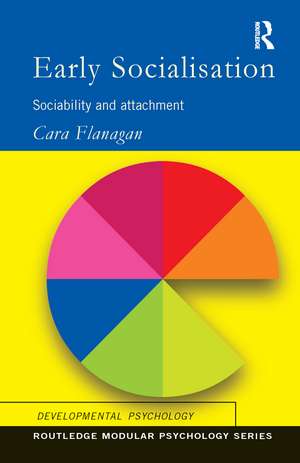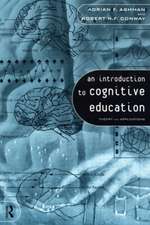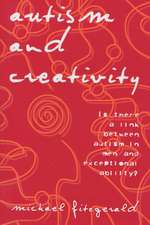Early Socialisation: Sociability and Attachment: Routledge Modular Psychology
Autor Cara Flanaganen Limba Engleză Hardback – 27 ian 2017
| Toate formatele și edițiile | Preț | Express |
|---|---|---|
| Paperback (1) | 297.27 lei 3-5 săpt. | +25.98 lei 6-12 zile |
| Taylor & Francis – 5 aug 1999 | 297.27 lei 3-5 săpt. | +25.98 lei 6-12 zile |
| Hardback (1) | 764.20 lei 6-8 săpt. | |
| Taylor & Francis – 27 ian 2017 | 764.20 lei 6-8 săpt. |
Din seria Routledge Modular Psychology
-
 Preț: 153.81 lei
Preț: 153.81 lei -
 Preț: 284.45 lei
Preț: 284.45 lei -
 Preț: 297.27 lei
Preț: 297.27 lei -
 Preț: 294.82 lei
Preț: 294.82 lei - 17%
 Preț: 237.44 lei
Preț: 237.44 lei - 18%
 Preț: 241.75 lei
Preț: 241.75 lei -
 Preț: 344.12 lei
Preț: 344.12 lei - 17%
 Preț: 237.44 lei
Preț: 237.44 lei - 17%
 Preț: 166.34 lei
Preț: 166.34 lei - 18%
 Preț: 235.63 lei
Preț: 235.63 lei - 17%
 Preț: 244.70 lei
Preț: 244.70 lei - 17%
 Preț: 242.28 lei
Preț: 242.28 lei - 17%
 Preț: 239.26 lei
Preț: 239.26 lei - 17%
 Preț: 239.26 lei
Preț: 239.26 lei -
 Preț: 359.68 lei
Preț: 359.68 lei -
 Preț: 361.76 lei
Preț: 361.76 lei -
 Preț: 340.45 lei
Preț: 340.45 lei -
 Preț: 341.03 lei
Preț: 341.03 lei - 17%
 Preț: 242.84 lei
Preț: 242.84 lei - 17%
 Preț: 246.12 lei
Preț: 246.12 lei - 18%
 Preț: 241.43 lei
Preț: 241.43 lei - 17%
 Preț: 242.36 lei
Preț: 242.36 lei - 17%
 Preț: 245.51 lei
Preț: 245.51 lei -
 Preț: 346.62 lei
Preț: 346.62 lei - 5%
 Preț: 1144.71 lei
Preț: 1144.71 lei -
 Preț: 339.53 lei
Preț: 339.53 lei -
 Preț: 341.75 lei
Preț: 341.75 lei - 25%
 Preț: 767.74 lei
Preț: 767.74 lei
Preț: 764.20 lei
Preț vechi: 1154.58 lei
-34% Nou
Puncte Express: 1146
Preț estimativ în valută:
146.32€ • 152.36$ • 121.40£
146.32€ • 152.36$ • 121.40£
Carte tipărită la comandă
Livrare economică 14-28 februarie
Preluare comenzi: 021 569.72.76
Specificații
ISBN-13: 9781138150355
ISBN-10: 1138150355
Pagini: 192
Dimensiuni: 141 x 210 mm
Greutate: 0.45 kg
Ediția:1
Editura: Taylor & Francis
Colecția Routledge
Seria Routledge Modular Psychology
Locul publicării:Oxford, United Kingdom
ISBN-10: 1138150355
Pagini: 192
Dimensiuni: 141 x 210 mm
Greutate: 0.45 kg
Ediția:1
Editura: Taylor & Francis
Colecția Routledge
Seria Routledge Modular Psychology
Locul publicării:Oxford, United Kingdom
Public țintă
UndergraduateCuprins
List of illustrations -- Acknowledgements -- 1 Introduction -- Some early views of childhood -- The beginnings of childhood -- This century -- The maternal deprivation hypothesis -- Evaluation -- Imprinting and bonding -- Imprinting, bonding and attachment -- Bowlby's theory of attachment -- Sociability -- Cross-cultural research -- Summary -- 2 Sociability -- Introduction -- Innate social abilities -- Specific behaviours -- Emotional expression -- Emotional sensitivity -- Learned social abilities -- Nature and nurture -- An interest in faces -- More and more smiles -- Reciprocal relationships -- Ethical and methodological issues -- Individual differences -- Innate factors -- The influence of others -- Summary -- 3 Imprinting and bonding -- Introduction -- Imprinting -- Konrad Lorenz and greylag geese -- Critical period hypothesis -- Sensitive period -- Supra-individual -- Consequences of imprinting -- Evaluation -- Bonding in non-human animals -- Wire mothers -- Experimental variations -- Conclusions -- Evaluation of non-human research -- Bonding in humans -- Skin-to-skin contact -- Evaluation -- Ethical and practical concerns -- What bonding research means for attachment -- Summary -- 4 The attachment process -- Introduction -- What is attachment? -- The development of attachment behaviour -- 1 The asocial stage -- 2 Indiscriminate attachments -- 3 Specific attachments -- 4 Multiple attachments -- Understanding why these changes take place -- Evaluation -- Individual differences in attachment -- Measuring attachment -- What the Strange Situation measures -- Types of attachment -- Stability of attachment -- Evaluation -- The value of a secure attachment -- Short-term effects: benefits of secure attachment -- Long-term effects: emotional development and relationships -- Long-term effects: parenting -- Long-term effects: personality development -- Long-term effects: self-esteem -- Long-term effects: cognitive development -- Evaluation -- Monotropy versus multiple attachments -- Monotropy -- The case for multiple attachments -- Evaluation -- Summary -- 5 Privation -- Introduction -- Children reared in isolation -- The Koluchova twins (PM and JM) -- Genie -- Evaluation -- Institutionalisation -- Skeels' study -- Tizard's study -- Evaluation of Tizard's study -- Other studies -- Romanian orphans -- Conclusions -- Reactive attachment disorder -- The effects of privation -- Some conclusions -- Privation or deprivation? -- A sensitive period? -- Individual differences in coping -- Methodology -- What does it matter? -- Summary -- 6 Separation -- Introduction -- Responses to separation -- Separation anxiety -- Criticisms of the POD model -- Hospitalisation -- Hospitals and later maladjustment -- Evaluation -- Day care -- Day care in a nursery -- Day care with a childminder -- Attachment to day-care provider -- Evaluation -- Divorce -- Parental discord -- Explanations -- Final evaluation of separation experiences -- Summary -- 7 Social and cultural variations -- Introduction -- What is 'cultural variation'? -- Cultural variations in attachment -- Cultural similarities -- The Strange Situation -- The Strange Situation as an imposed etic -- One or many attachments? -- Are there any differences? -- Attachment and economics -- Conclusions -- Cultural variations in childrearing -- Studies of Western childrearing styles -- Evaluation -- Social class (sub-cultural) differences -- Cross-cultural studies -- Conclusion -- Summary -- 8 Theories of attachment -- Introduction -- What is a theory of attachment? -- Attachment theory before Bowlby -- Freudian theory -- Behaviourist theory -- Evaluation of Freudian and behaviourist approaches -- The ethological approach -- Bowlby's theory -- The influence of psychoanalysis: maternal deprivation -- The influence of ethology: attachment theory -- A critical or sensitive period -- Is attachment innate? -- Monotropy -- The internal working model -- Caregiver sensitivity hypothesis -- A secure base -- Attachment theory -- Evaluation of Bowlby's theory -- Rutter's commentary: maternal deprivation reassessed -- Other criticisms of Bowlby's theory -- Final analysis -- Summary -- 9 Enrichment -- Introduction -- What is enrichment? -- Cognitive development -- Perceptual development -- The effect of institutionalisation -- Other studies of visual deprivation -- Conclusion -- Language development -- Linguistic enrichment -- Criticisms of verbal deprivation theory -- Reading -- Speech -- Development of intelligence -- Hothousing -- Preschool enrichment programmes -- Nutritional enrichment -- Intelligence enrichment programmes: conclusions -- Social and emotional development -- Popularity -- Attachment -- Conclusions -- Summary -- 10 Study aids -- Practice essays -- Key research summaries -- Bowlby (1946) Forty-four juvenile thieves -- Schaffer and Emerson (1964) The development of social attachments in infancy -- Fox (1977) Attachment of kibbutz infants to mother and metapelet -- Glossary -- References -- Index.
Notă biografică
Cara Flanagan is an experienced author and Assessor and TeamLeader for AEB A-level psychology. Her most recent books includePracticals for psychology (Routledge 1998), Psychology A-level studyguide (1994) and Applying psychology to early childhood development(1996). She is a co-editor for the series with Kevin Silber.
Descriere
This book looks at sociability and attachment and how they relate to emotional and cognitive development. Social and cultural variations are considered, and theories of attachment and loss are described and evaluated.





















